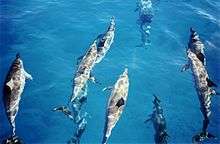List of mammals of Kiribati
This is a list of the mammal species recorded in Kiribati. There are 7 mammal species in Kiribati, all of which are marine mammals in the order Cetacea. None are thought to be at risk, but some have insufficient data collected on them to allow an assessment to be made.[1]
The marine mammals of the order Cetacea that have been identified in the Pacific is described in the literature review by Miller (2006)[2] and by the Secretariat of the Pacific Regional Environment Programme(SPREP).[3] A revision of the list of cetaceans reported in the ocean surrounding the islands of Kiribati was carried by Miller (2009),[4]
The following tags are used to highlight each species' conservation status as assessed by the IUCN:
| DD | Data Deficient | There is inadequate information to make an assessment of the risks to this species. |
Some species were assessed using an earlier set of criteria. Species assessed using this system have the following instead of Near Threatened and Least Concern categories:
| LR/cd | Lower Risk/conservation dependent | Species which were the focus of conservation programmes and may have moved into a higher risk category if that programme was discontinued. |
| LR/nt | Lower Risk/near threatened | Species which are close to being classified as Vulnerable but are not the subject of conservation programmes. |
| LR/lc | Lower Risk/least concern | Species for which there are no identifiable risks. |
Subclass: Theria
Infraclass: Eutheria
Order: Cetacea (whales)
The order Cetacea includes whales, dolphins and porpoises. They are the mammals most fully adapted to aquatic life with a spindle-shaped nearly hairless body, protected by a thick layer of blubber, and forelimbs and tail modified to provide propulsion underwater.
Lack of studies and dedicated observation efforts result in poor understanding of cetacean diversities in the region.[5]
- Suborder: Mysticeti
- Family: Balaenidae
- Genus: Eubalaena
- Southern right whale, Eubalaena australis LR/cd[6]
- Genus: Eubalaena
- Family: Balaenidae
- Suborder: Odontoceti
- Family: Physeteridae
- Genus: Physeter
- Sperm whale Physeter macrocephalus VU[7]
- Genus: Physeter
- Superfamily: Platanistoidea
- Family: Kogiidae
- Genus: Kogia
- Dwarf Sperm Whale Kogia sima LR/lc
- Genus: Kogia
- Family: Ziphidae
- Subfamily: Hyperoodontinae
- Genus: Hyperoodon
- Southern bottlenose whale, Hyperoodon planifrons LR/cd
- Genus: Mesoplodon
- Blainville's Beaked Whale Mesoplodon densirostris DD
- Ginkgo-toothed Beaked Whale Mesoplodon ginkgodens DD
- Deraniyagala's beaked whale Mesoplodon hotaula DD
- Genus: Hyperoodon
- Subfamily: Hyperoodontinae
- Family: Delphinidae (marine dolphins)
- Genus: Steno
- Rough-toothed Dolphin Steno bredanensis DD
- Genus: Stenella
- Spinner Dolphin Stenella longirostris LR/cd
- Genus: Lagenodelphis
- Fraser's Dolphin Lagenodelphis hosei DD
- Genus: Globicephala
- Short-finned pilot whale, Globicephala macrorhynchus LR/cd
- Genus: Feresa
- Pygmy Killer Whale Feresa attenuata DD
- Genus: Orcinus
- Orca, Orcinus orca LR/cd
- Genus: Steno
- Family: Kogiidae
- Family: Physeteridae
Notes
- ↑ This list is derived from the IUCN Red List which lists species of mammals and includes those mammals that have recently been classified as extinct (since 1500 AD). The taxonomy and naming of the individual species is based on those used in existing Wikipedia articles as of 21 May 2007 and supplemented by the common names and taxonomy from the IUCN, Smithsonian Institution, or University of Michigan where no Wikipedia article was available.
- ↑ Miller, Cara (14 February 2006). Current State of Knowledge of Cetacean Threats, Diversity and Habitats in the Pacific Islands Region. WDCS Australasia Inc. p. 98.
- ↑ "Secretariat of the Pacific Regional Environment Programme(SPREP)" (PDF). Pacific Islands Regional Species Programme 2008-2012. 2008. Retrieved 9 October 2013.
- ↑ Miller, Cara (1 July 2009). Current State of Knowledge of Cetacean Threats, Diversity and Habitats in the Pacific Islands Region (PDF). WDCS Australasia Inc. pp. 49–50.
- ↑ http://uk.whales.org/sites/default/files/whales-and-dolphins-in-the-pacific-islands.pdf
- ↑ Miller E.C. (2007). "Current State of Knowledge of Cetacean Threats, Diversity, and Habitats in the Pacific Islands Region" (pdf). Whale and Dolphin Conservation Society Australasia. p. 44. Retrieved 2 January 2016.
- ↑ http://www.pbs.org/odyssey/odyssey/20010212_log_transcript.html
References
- "The IUCN Red List of Threatened Species: Mammals of Kiribati". IUCN. 2001. Retrieved 22 May 2007.
- "Mammal Species of the World". Smithsonian National Museum of Natural History. 2005. Archived from the original on 27 April 2007. Retrieved 22 May 2007.
- "Animal Diversity Web". University of Michigan Museum of Zoology. 1995–2006. Retrieved 22 May 2007.
See also
- List of chordate orders
- List of regional mammals lists
- List of prehistoric mammals
- Mammal classification
- New mammal species
- Pacific Islands Cetaceans Memorandum of Understanding
